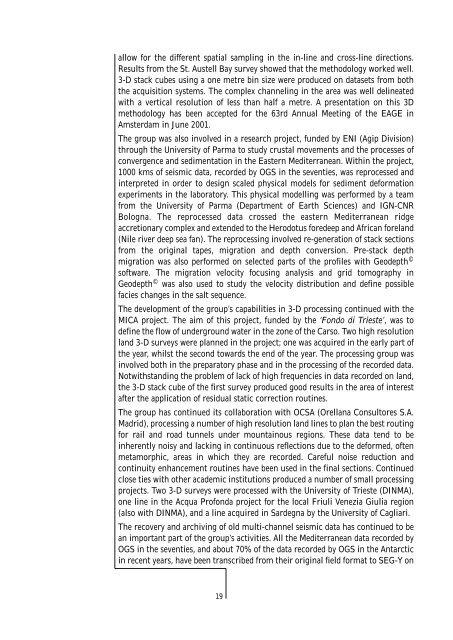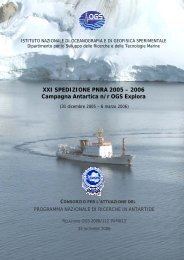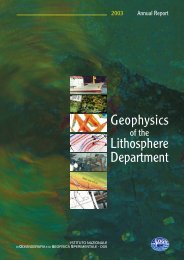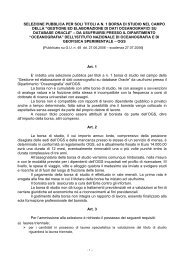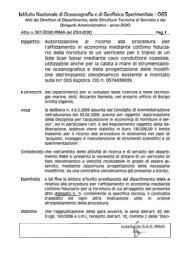Geophysical data acquisition - OGS
Geophysical data acquisition - OGS
Geophysical data acquisition - OGS
You also want an ePaper? Increase the reach of your titles
YUMPU automatically turns print PDFs into web optimized ePapers that Google loves.
allow for the different spatial sampling in the in-line and cross-line directions.<br />
Results from the St. Austell Bay survey showed that the methodology worked well.<br />
3-D stack cubes using a one metre bin size were produced on <strong>data</strong>sets from both<br />
the <strong>acquisition</strong> systems. The complex channeling in the area was well delineated<br />
with a vertical resolution of less than half a metre. A presentation on this 3D<br />
methodology has been accepted for the 63rd Annual Meeting of the EAGE in<br />
Amsterdam in June 2001.<br />
The group was also involved in a research project, funded by ENI (Agip Division)<br />
through the University of Parma to study crustal movements and the processes of<br />
convergence and sedimentation in the Eastern Mediterranean. Within the project,<br />
1000 kms of seismic <strong>data</strong>, recorded by <strong>OGS</strong> in the seventies, was reprocessed and<br />
interpreted in order to design scaled physical models for sediment deformation<br />
experiments in the laboratory. This physical modelling was performed by a team<br />
from the University of Parma (Department of Earth Sciences) and IGN-CNR<br />
Bologna. The reprocessed <strong>data</strong> crossed the eastern Mediterranean ridge<br />
accretionary complex and extended to the Herodotus foredeep and African foreland<br />
(Nile river deep sea fan). The reprocessing involved re-generation of stack sections<br />
from the original tapes, migration and depth conversion. Pre-stack depth<br />
migration was also performed on selected parts of the profiles with Geodepth ©<br />
software. The migration velocity focusing analysis and grid tomography in<br />
Geodepth © was also used to study the velocity distribution and define possible<br />
facies changes in the salt sequence.<br />
The development of the group’s capabilities in 3-D processing continued with the<br />
MICA project. The aim of this project, funded by the ‘Fondo di Trieste’, was to<br />
define the flow of underground water in the zone of the Carso. Two high resolution<br />
land 3-D surveys were planned in the project; one was acquired in the early part of<br />
the year, whilst the second towards the end of the year. The processing group was<br />
involved both in the preparatory phase and in the processing of the recorded <strong>data</strong>.<br />
Notwithstanding the problem of lack of high frequencies in <strong>data</strong> recorded on land,<br />
the 3-D stack cube of the first survey produced good results in the area of interest<br />
after the application of residual static correction routines.<br />
The group has continued its collaboration with OCSA (Orellana Consultores S.A.<br />
Madrid), processing a number of high resolution land lines to plan the best routing<br />
for rail and road tunnels under mountainous regions. These <strong>data</strong> tend to be<br />
inherently noisy and lacking in continuous reflections due to the deformed, often<br />
metamorphic, areas in which they are recorded. Careful noise reduction and<br />
continuity enhancement routines have been used in the final sections. Continued<br />
close ties with other academic institutions produced a number of small processing<br />
projects. Two 3-D surveys were processed with the University of Trieste (DINMA),<br />
one line in the Acqua Profonda project for the local Friuli Venezia Giulia region<br />
(also with DINMA), and a line acquired in Sardegna by the University of Cagliari.<br />
The recovery and archiving of old multi-channel seismic <strong>data</strong> has continued to be<br />
an important part of the group’s activities. All the Mediterranean <strong>data</strong> recorded by<br />
<strong>OGS</strong> in the seventies, and about 70% of the <strong>data</strong> recorded by <strong>OGS</strong> in the Antarctic<br />
in recent years, have been transcribed from their original field format to SEG-Y on<br />
19


